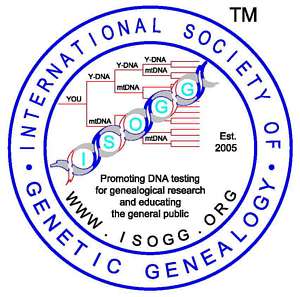Y-DNA Haplogroup K and its Subclades - 2008
The entire work is identified by the Version Number and date given on the
Main Page. Directions for citing the document are given at
the bottom of the Main
Page.
Version History Last
revision date for this specific page: 23 December 2008
Because of continuing research, the structure of the Y-DNA Haplogroup Tree changes and ISOGG
does its best to keep the tree updated with the latest developments
in the field. The viewer may observe other versions of the tree on the Web. Email
Alice Fairhurst if the differences need
clarification.
K M9, P128, P131, P132
�
K* -
�
K1 M147
(formerly K3)
�
K2 P60, P304, P308
(formerly K4)
�
K3 P79, P299, P307
(formerly K6)
�
K4 P261, P263
�
L
M11, M20, M22, M61, M185, M295
�
M
P256
�
NO
M214, P188, P192, P193, P194, P195
�
P
92R7, M45, M74/N12, P27.1/P207, P69, P226, P228, P230, P235, P237,
P239, P240, P243, P244, P281, P282, P283, P284, P295,
�
S
M230, P202, P204 (formerly K5)
�
T
M70, M184/USP9Y+3178, M193, M272 (formerly K2)
NOTES:
- The Karafet et al (2008) paper made a major change to Haplogroup K. The subgroups formerly
known as K1 and K7 was moved to M2 and M3, respectively, and K2 and K5 became Haplogroups T and S, respectively.
- The 50f2/C deletion in the AZFc region of the human Y chromosome has been observed in several
different haplogroups and is not a unique event polymorphism. It is notable, however, that it
has been detected at relatively high levels in subgroups of K in Melanesia - K* (21%), and K3 (14%).
- Identical SNPs that were discovered separately are listed in alphabetical order, not necessarily in
the order of discovery, and separated by "/". Examples: M74/N12, M184/USP9Y+3178.
Y-DNA haplogroup K is an old lineage established approximately 40,000
thousand years ago whose origins were probably in southwestern
Asia. At present this group contains two distinct
classes of subgroups: (1) major groups L to T
(refer to the main tree at Y-DNA Haplogroup Tree)
and (2) minor groups K* and K1 to K4 which do not have any of the SNPs defining
the major groups. These groups are found at low frequencies in various parts
of Africa, Eurasia, Australia and the South Pacific.
References:
Alonso et al,
The Place of the Basques in the European
Y-chromosome Diversity Landscape. (available by subscription) European Journal of
Human Genetics, 13:1293-1302, 2005.
Bortolini et al,
Y-Chromosome Evidence for Differing Ancient Demographic Histories in the Americas.
American Journal of Human Genetics, 73:524�539, (2003).
Cinnioglu et al,
Excavating Y-chromosome Haplotype Strata in Anatolia. (pdf) Human Genetics. 114:127-148, 2004.
Cox M P & Lahr M M,
Y-Chromosome Diversity Is Inversely Associated with Language Affiliation in Paired
Austronesian- and Papuan-Speaking Communities from Solomon Islands. (pdf)
American Journal of Human Biology, 18:35-50, 2006.
Cruciani et al,
A Back Migration from Asia to Sub-Saharan Africa Is Supported
by High-Resolution Analysis of Human Y-Chromosome Haplotypes. (pdf)
American Journal of Human Genetics, 70:1197-1214, 2002.
Deng et al, Evolution
and Migration History of the Chinese Population Inferred from the Chinese Y-chromosome Evidence.
(pdf) Journal of Human Genetics, 49:339-348, 2004.
Flores et al,
Reduced Genetic Structure of the Iberian Peninsula Revealed by Y-chromosome
Analysis: Implications for Population Demography. (pdf)
European Journal of Human Genetics,
12:855-863, 2004.
Hudjashov G,
Peopling of Sahul: Evidence from mtDNA and Y-Chromosome.
Thesis (M.SC.) University of Tartu, Estonia, 2006.
Karafet et al,
New Binary Polymorphisms Reshape and Increase Resolution of the Human Y-Chromosomal Haplogroup
Tree. Abstract. Genome Research, published online April 2, 2008.
Supplementary Material.
Kayser et al,
Independent Histories of Human Y Chromosomes from Melanesia and Australia.
American Journal of Human Genetics, 68:173-190, 2001.
Kayser et al,
Melanesian and Asian Origins of Polynesians: mtDNA and Y-Chromosome Gradients across
the Pacific. MBE Advance Access published August 21, 2006.
Kayser et al.
Reduced Y-Chromosome, but Not Mitochondrial DNA, Diversity in Human Populations from West New
Guinea. American Journal of Human Genetics, 72:281-302, 2003.
Kivisild et al,
The Genetic Heritage of the Earliest Settlers Persists in Both Indian Tribal and Caste
Populations. (pdf) American Journal of Human Genetics, 72:313-332, 2003.
Mona et al,
Patterns of Y-chromosome Diversity Intersect with the Trans-New Guinea Hypothesis.
Mol Biol Evol. 2007 Sep 10; [Epub ahead of print]
Regueiro et al,
Iran: Tricontinental Nexus for Y-Chromosome Driven Migration. (abstract)
Human Heredity, Vol. 61, No 3, 132-143, 2006.
Scheinfeldt et al,
Unexpected NRY Chromosome Variation in Northern Island Melanesia. (Link and comments from
Dienekes' Anthropological Blog) Society for Molecular Biology, 2006.
Semino et al,
Ethiopians and Khoisan Share the Deepest Clades of the Human Y-Chromosome Phylogeny. (pdf)
American Journal of Human Genetics, 70:265-268, 2002.
Sengupta et al,
Polarity and Temporality of High Resolution Y-chromosome Distributions in India
Identify Both Indigenous and Exogenous Expansions and Reveal Minor Genetic Influence
of Central Asian Pastoralists. (pdf)
American Journal of Human Genetics, 78:202-221, 2006.
Shen et al, Reconstruction
of Patrilineages and Matrilineages of Samaritans and other Israeli Populations from Y-Chromosome
and Mitochondrial DNA Sequence Variation. (pdf) Human Mutation, 24:248-260, 2004.
Su et al,
Y-chromosome Evidence for a Northward Migration of Modern Humans into Eastern Asia
during the Last Ice Age. (pdf) American Journal of Human Genetics, 65:1718-1724, 1999.
Thangaraj et al,
Genetic Affinities of the Andaman Islanders, a Vanishing Human Population. (pdf)
Current Biology, 13:86-93, 2003.
Additional Resources:
Corrections/Additions made since 31 December 2007:
- Added Karafet et al (2008) on 4 May 2008.
- First paragraph of Haplogroup description revised 4 May 2008.
- SNPs to added to Haplogroup K on 4 May 2008: P128, P131, P132, P256, P261, P263.
- Fixed hyperlinks to S and T on 5 May 2008.
- Fixed misspelling of subgroups on 5 May 2008.
- Added P299, P304, P307, P308 on 22 December 2008.
- Removed P245 and S25 from P on 23 December 2008.
-
Contact Person for Haplogroup K:
Gareth Henson

